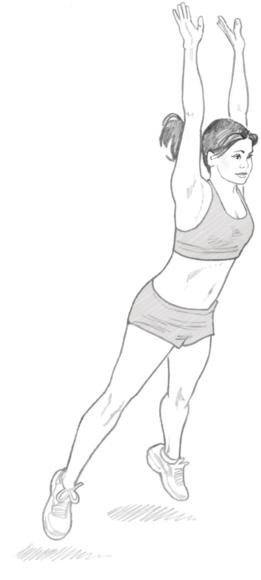Learn this exercise: frogger
This is an excerpt from Running Anatomy 2nd Edition by Joe Puleo,Patrick Milroy.


Midair position.
Execution
- Position the body in a full squat position with the feet slightly apart and the thighs horizontal to the ground. The lower back is gently arched, the head is centered, and the chin is slightly raised. The arms are extended in front of the body.
- Inhale deeply while sweeping the arms backward and then quickly forward, thus developing momentum to help the legs explode from the full squat position at a 60-degree angle as the arms are thrown above the head. Upon reaching the apex of the jump, prepare to land. Upon landing, lower the body into the same position (full squat) as when the exercise started.
- The movement will carry you slightly forward, thus emphasizing strength in both the vertical and the horizontal plane.
- Upon reestablishing proper squat form, immediately repeat the jump.
Muscles Involved
- Primary: Quadriceps (rectus femoris, vastus lateralis, vastus medialis, vastus intermedius), gluteus maximus, gastrocnemius, soleus
- Secondary: Hamstrings (semitendinosus, semimembranosus, biceps femoris), deltoid, rectus abdominis, external oblique, internal oblique
Running Focus

The frogger is a propulsive exercise that requires the athlete to explode from the start position by engaging the quadriceps, hamstrings, and glutes. It offers a practical application for sprinters (starting from a block) and, like all plyometric exercises, can also help distance runners increase running economy by strengthening the affected muscles, thus reducing energy consumption.
Learn more about Running Anatomy, Second Edition.
More Excerpts From Running Anatomy 2nd EditionSHOP

Get the latest insights with regular newsletters, plus periodic product information and special insider offers.
JOIN NOW


